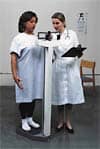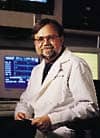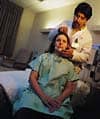Diversity Is Key

This sleep disorders center is also the only accredited center located in a department of psychology. In a time when most sleep centers are located in departments of medicine, the clinic remains true to its early roots in psychology, and that factor has helped it stay in the forefront of the sleep study field. “Twenty years ago, there were relatively few pulmonary departments interested in sleep studies. At that time, centers were more commonly located in departments of psychiatry or neurology,” says Edward J. Stepanski, PhD, laboratory director of the center since July 1998. “Placing sleep centers in departments of psychiatry was probably due to the bias[ed opinion] that sleep disorders were related to psychiatric conditions. Neurology departments were also involved early on because of the use of electroencephalography in sleep studies.” Today, many centers do not have psychologists working in them, but instead refer to psychologists working in the community. “One problem with this practice is that these psychologists are not boarded in sleep,” he says. “Our program definitely has more experience in that field.”
The clinic’s location within the psychology department has helped it maintain a multidisciplinary staff, according to Stepanski. The center’s staff includes specialists in neurology, psychology, psychiatry, and pulmonary medicine, all of whom are capable of diagnosing and treating more than 80 known sleep disorders.
“In other places, that diversity is getting harder to maintain,” he says. “Simply put, if a center is located in the department of neurology, it is less likely that pulmonary medicine will be involved. Likewise, in many places, the department of pulmonary medicine is less likely to include neurology. For our part, we are able to avoid such turf issues.”
Staff Makeup
The Sleep Disorder Clinic boasts greater expertise in the psychological side of the field, especially treatment of insomnia, enuresis, and parasomnias. Since it opened, the center has seen more than 7,000 people ranging from age 6 to 96. Sleep studies on very young children and infants are carried out in another department within Rush-Presbyterian-St Luke’s Medical Center. The center has a staff of seven, in addition to a dentist who comes every other week to fit appliances for apnea patients. Stepanski says that is a unique aspect of the center as well since sleep centers usually refer their patients to someone in the community for any required dental work.
“Dr Cartwright pioneered the use of oral appliances in the treatment of sleep apnea with her work on the tongue-retaining device,” he says. “She feels that it is an important treatment modality and, as a result, patients can come to the sleep center to get fitted for any necessary oral appliance.”
Patient Breakdown
Half the clinic’s patients are referred from physicians at Rush and the other half are referrals from outside physicians and clinical psychologists. All patients and their referring physicians receive full reports of the findings and treatment recommendations. Although home studies are an option for research purposes, all clinical work is done within the center. The center consists of six bedrooms, which are decorated like hotel rooms for maximum patient comfort. The examination and interview rooms and conference areas are in one location contiguous with the sleep bedrooms.

“While we have explored the possibility of doing home studies clinically for follow-up in established diagnoses, they are not used clinically at this point,” Stepanski says. “The reason is that we think we can get a better result by studying in the laboratory. For instance, if we need to do a split-night study, we can’t do that in the patient’s home. If there are other diagnostic questions besides sleep apnea, we also need to do an in-laboratory study.”
Most patients participate in a one-night sleep study, and Ste-panski says the clinic is privileged to be able to see every patient prior to doing the sleep study.
“Individual consultation prior to the sleep study used to be the model for sleep laboratories, but managed care changes make it harder for laboratories to continue doing that,” he says. “We have maintained that model because we feel it leads to better outcomes for our patients. It gives us the ability and the time to perform education about what sleep disorder we are looking for and about the test itself—and that education up front is very helpful.
“On the contrary, when patients are told very little about sleep apnea, for instance, they understand little about why wearing a mask helps them,” he says. “That makes it easier for them not to follow up.”
Like most sleep centers, Stepanski says the majority of the clinic’s patients come in for apnea issues.
“We have a lot of patients with movement disorders and there is a neurologist on staff who treats those cases,” he says. “Increasingly, we see patients who have been evaluated elsewhere and have had bad outcomes. It used to be that sleep study patients were fresh, but now a larger percentage have already had evaluations at community hospitals and are trying to figure out why they are still not feeling better.”
Within the few days following their sleep study, patients are either rescheduled for a face-to-face follow-up or called with results, at which point treatment is prescribed. The most common prescriptions at the Sleep Disorder Clinic are nasal continuous positive airway pressure, position training for keeping apnea patients in a supine position, medication for issues such as restless legs syndrome, and cognitive behavioral treatment for insomnia. In addition, the center offers a weight loss group for sleep apnea patients.
Research
In addition to clinical work, research studies take up a fair amount of time and space at the Sleep Disorders Center. Stepanski says the center does a combined 120 research and clinical studies each month.
“The clinic is doing twice as many studies now as when I first came 3 years ago,” Stepanski says. “But we have been lucky to be able to flex the space between research and clinical studies so there is not a long waiting list on the clinical side of the practice.” In 1997, Cartwright started a study that examines how mood regulates the effects of rapid eye movement(REM) sleep, and specifically targets pa-tients undergoing a divorce.

Qualified participants must have taken the first step toward becoming divorced such as separating with the intent to divorce or must have experienced divorce within the past year. Participants also must not be in therapy or taking antidepressant drugs. The study is funded by the National Institutes of Health (NIH) and just received additional funding. It will be finished over the next 2 years. “The study looks at how sleep changes in those going through a divorce as they get over their depression,” Stepanski says.
A new NIH study that began last August is looking at treating insomnia in elderly patients with medical disorders, specifically arthritis, chronic obstructive pulmonary disease, and coronary artery disease.
“The idea is that cognitive behavioral treatment will benefit those patients who frequently experience disturbed sleep and don’t tolerate sleeping medications,” he says. “Therefore, nonpharmacological treatment may be best.”
Other research projects currently under way involve studying the sleep of patients with Parkinson’s disease—many of whom are found to have REM behavior disorder. Following evaluation of these patients, the project is constructing a clinical questionnaire to screen other such patients for sleep disorders. Charmane Eastman, PhD, director of the biological rhythms laboratory, recently began a 3-year study of the ability of bright light to phase-shift the sleep-wake rhythm of shift workers. The center also is host to an ongoing project examining sleep and startle response in monozygotic twins who are post-traumatic stress disorder discordant. The range of research and clinical approaches at the Sleep Disorder Clinic are further evidence that the facility remains on the forefront of this niche.
“When this clinical program started, it was the first program in Illinois of its kind, though there were some research programs elsewhere in the state,” he says. “Dr Cartwright’s leadership has garnered positive attention for the center over the years and it has become valued as an important clinical program at Rush.”
Liz Finch is a contributing writer for Sleep Review.





